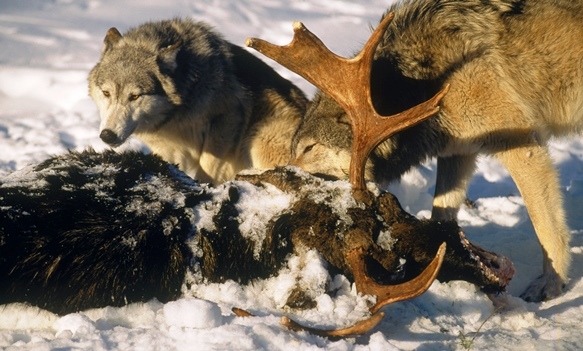One notable study of predator-prey relationships, specifically between wolves and moose, has been conducted on Isle Royale since the late 1950s. Isle Royale is the largest island in Lake Superior. It was established as a national park in the United States in 1940 and is a designated wilderness area, protected from development. As such, the animals that live on Isle Royale have provided researchers with a unique opportunity to study predator-prey interactions, especially because the isolation of this island has enabled scientists to avoid having to consider any immediate interference from humans. In particular, the observed relationship of wolves and moose on the island has enabled ecologists to determine fascinating aspects of intertwined animal population dynamics. See also: Conservation (species); Dogs; Ecological communities; Ecological modeling; Ecology; Moose; Predator-prey interactions

Population dynamics—that is, changes in the sizes of populations of organisms through time—are often studied by conservationists and ecological researchers. In general, the interactions of predators and their prey play a chief role in explaining the population dynamics of numerous animal species. For example, predators affect the population dynamics of prey because an increase in the density of the predator population leads to increased predation on the prey and a consequent decrease in the prey's population growth rate. Conversely, an increase in the density of prey leads to more potential food for predators and a consequent increase in the predator's population growth rate. Therefore, a predator-prey interaction can be viewed as an antagonistic interaction, in which the population of one species has a negative effect on the population of a second, whereas the second has a positive effect on the first. See also: Food web; Population ecology; Population viability; Theoretical ecology; Trophic ecology
The populations of wolves and moose on Isle Royale have fluctuated dramatically. The first moose arrived on the island in the early 1900s, possibly by swimming from the mainland or by "stocking" carried out by humans. The first wolves were a pair of animals that walked across an ice bridge from Ontario during a particularly cold winter in 1949. All of the subsequent wolves inhabiting the island descended from the initial pair, which led to population difficulties resulting from inbreeding. Investigators initially envisioned that a population equilibrium would have been reached between the predatory wolf and moose prey populations. However, this has not been observed. Instead, the wolf and moose populations have shifted antagonistically between high and low points. For example, the moose population (which was expected to hover around 1500 individuals) has ranged between 500 to 2500 since 1958, whereas the wolf population (which was expected to hover around 25 individuals) has fluctuated between 2 and 50. See also: Mathematical ecology; Population genetics
Scientists estimate that there are only 2 remaining wolves on Isle Royale. As a result, the numbers of moose on the island are increasing at a very rapid pace. Thus, conservationists fear that the growing moose population will eliminate the limited vegetation that they eat and need in order to survive, thereby leading to starvation of the animals. However, a continued presence of a genetically healthy wolf population on the island would provide a check on the booming moose numbers. Therefore, a new plan is being undertaken by the U.S. National Park Service to restock the wolf population. So far, 4 wolves (which have been equipped with GPS tracking collars) have been reintroduced on the island, with a further 20 to 30 individuals to come over the next few years. The goal is to re-establish a more satisfactory balance between the wolf and moose populations so that their precious dynamic relationship can be studied for future conservation projects. See also: Restoration ecology





